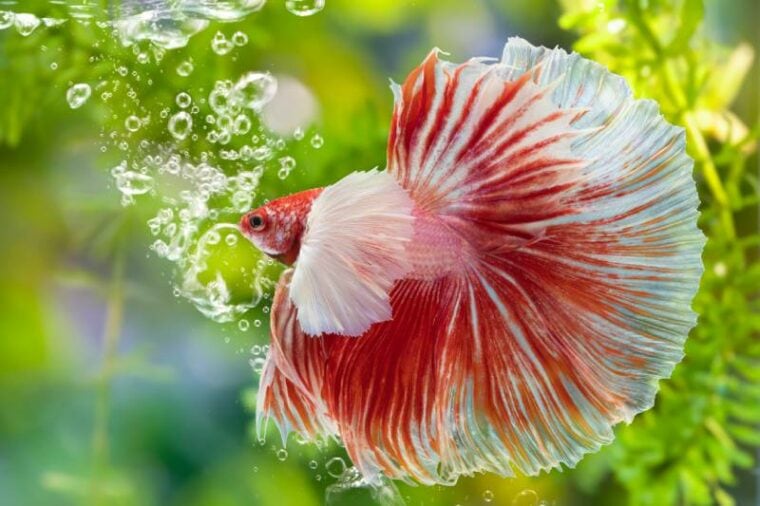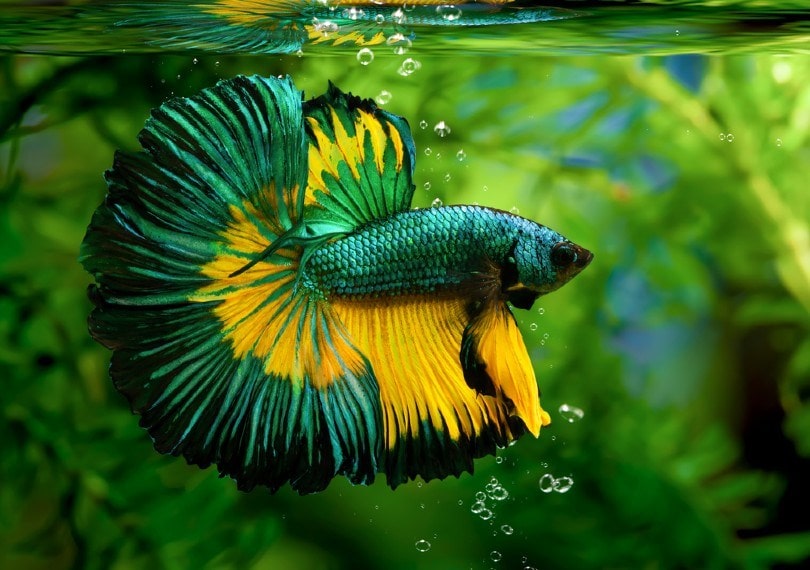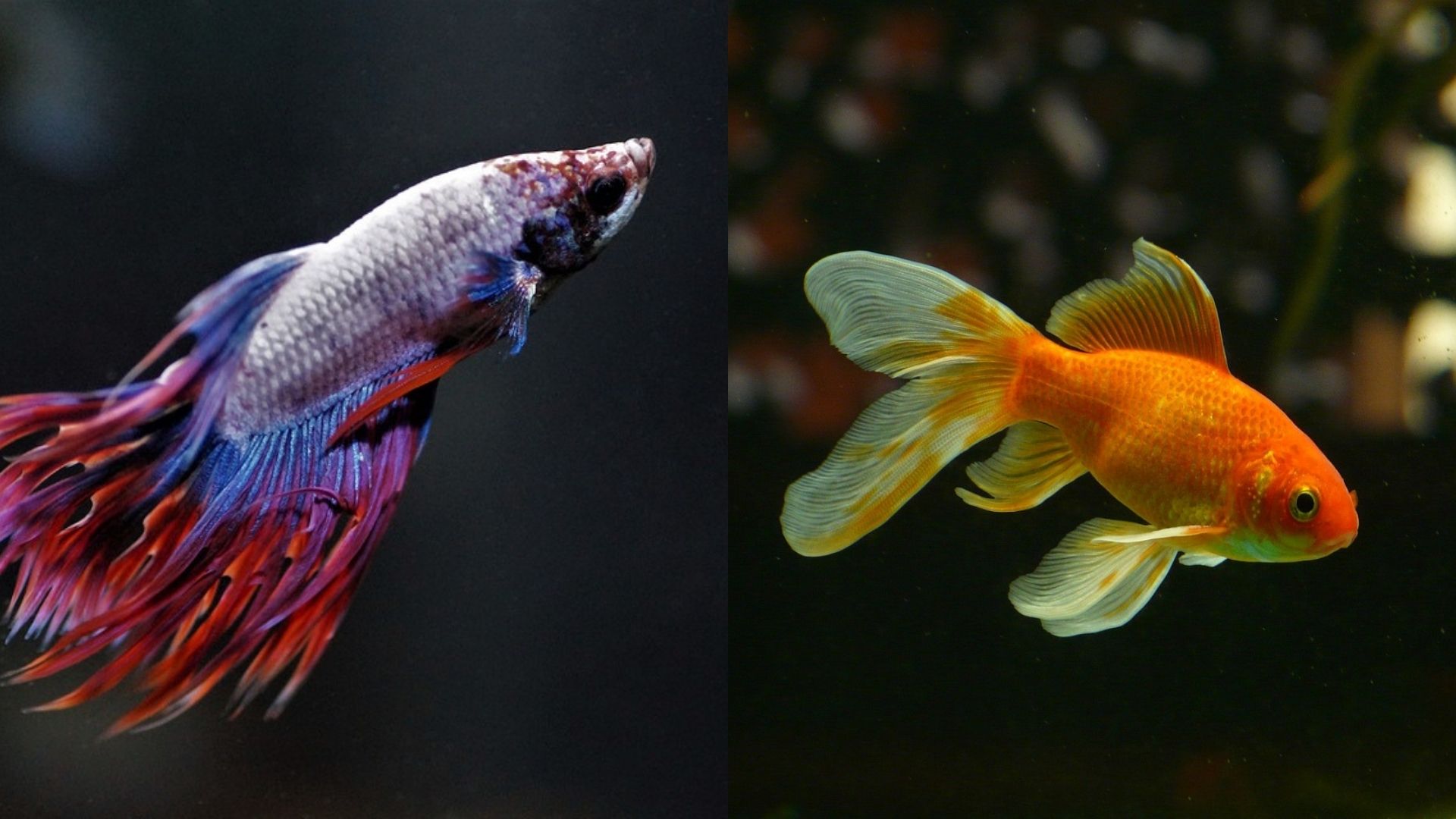
Click to Skip Ahead
In fish, flaring is a natural phenomenon where they push their fills outwards and hold their fins upright in an attempt to appear as large as possible. Though many fish flare, the trait is perhaps best observed in bettas.
Many owners are surprised to find that their betta flares at them from time to time. Though this might seem concerning, a betta occasionally flaring at you (especially as you approach their aquarium) is normal in most circumstances, and often not a worrisome sign in an otherwise healthy betta.
Read on as we explain this behavior.
Flaring – The Ultimate Pose
Many people often assume that bettas are aggressive fish that will “fight to the death” whenever the opportunity presents itself. This myth originates because the bettas kept as pets today were originally bred for aggressive traits and were often placed in small containers by onlookers who would essentially force these fish to fight. Fortunately, this practice has fallen out of favor.

The 3 Reasons Why Bettas Flare
The reasons for bettas to flare can be summarized as follows.
1. Conflict Avoidance
Bettas are instinctively territorial, and in a scenario where they’re placed in a new environment with another betta, they would most likely fight. However, from an evolutionary standpoint, it would make little sense for them to continuously fight all the time. Fighting costs a fish valuable resources in the form of energy and might predispose them to injuries, which can spiral into unwanted infections.
Essentially, bettas in the wild evolved to use flaring as a pose of sorts to warn an intruder of their presence. When they flare, they try to appear as intimidating as possible to a perceived intruder in an attempt to avoid an actual physical confrontation. If the approaching fish thinks that the opponent looks far too menacing (based on their flare), they will likely retreat and look for another territory to stake out as their own. This saves both the fish the hassle of a physical confrontation and therefore, is considered beneficial. If, however, the approaching fish feels confident in their ability to take over the territory, they may flare right back. This may lead to either a stand-off or an early retreat from one of the two fish.
Of course, at times, it is possible that neither fish would budge and eventually, they may have a scuffle. However, flaring does minimize the odds of this happening. This instinct is hardwired into the bettas sold as pets today. They flare at anything that they perceive is a threat to their territory.
Contrary to popular belief, it isn’t just males that flare this way. Female bettas also flare, even at males who they aren’t interested in.

2. Reproduction Display
When male bettas flare at a female, it is usually for one of two reasons. The first, as explained above, is a warning – males wouldn’t tolerate a non-breeding female in their territory. The second reason is for seduction. A male would flare at a female that seems capable of breeding in order to woo her. Their flare would demonstrate his strength and display a larger stature, which might increase his chances of successfully luring the female to their nest to mate with him.
3. Warning
At times, bettas instinctively flare at something new in their territory as a warning sign. This doesn’t necessarily have to be a new fish, it can be something like a new ornament placed in their environment. Bettas are inquisitive, and flaring and new objects or items tend to happen almost instantly when a betta suddenly notices something strange.
However, the exact mechanism of flaring is still not fully understood; it seems that the betta has to distinguish the new arrival as a threat before they flare up. For example, it has been observed that bettas almost never flare at food, as doing so would possibly give their potential meal a chance to escape.

Why Does My Betta Flare At Me?
If your betta flares at you, it’s likely that they are startled and instinctively flare at you when you approach them. Anecdotally, it has been reported that some bettas repeatedly flare at their owners whenever they approach, even from a distance. It has been reported that bettas have personalities and can be bred for certain traits. Likewise, a theory exists that bettas that bond strongly with their owners might flare out of excitement.
It seems very difficult to make a betta stop flaring and therefore, if your betta has no other health issues, you shouldn’t worry too much about their flaring habits. Though some experiments have been performed on bettas to modify their behaviors using medication, it seems that they eventually develop resistance to the medications and resume flaring at each other.

When Is Flaring Unhealthy?
In most instances, flaring is considered to be normal. At other times though, flaring can be a sign of distress. Many fish hold their gills outwards when they are infected with certain parasites or diseases that cause them discomfort. This is somewhat rare in bettas because they have two methods of breathing, and therefore, if their gills are irritated, they may not immediately hold them in a flared position. Nonetheless, it may happen at times of illness.
Unhealthy flaring can be distinguished from normal flaring because it is also associated with other signs of disease or distress.
If you suspect your betta is unwell, have them looked over by your aquatic or exotic veterinarian.
Conclusion
Bettas are instinctively known for flare for several reasons. If your betta flares at you, it’s usually because they are momentarily startled, or curious about your approach. At other times though, it might be because they’re anticipating your approach and flaring at you out of fondness – however, this remains to be definitively proven by science.
Though most instances of flaring are normal, flaring can be considered unhealthy if your betta seems to be displaying other signs of distress simultaneously. In such an event, it’s best to seek professional advice to ensure that your pet is not unwell.
Featured Image Credit: panpilai paipa, Shutterstock








